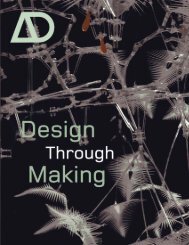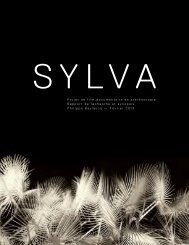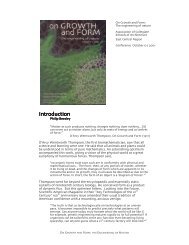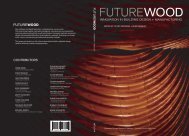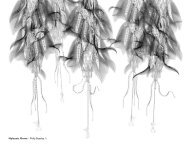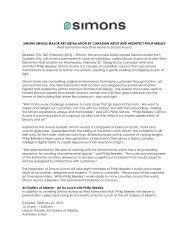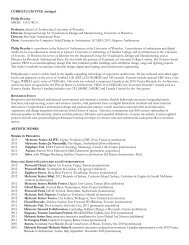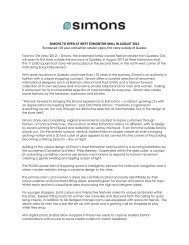Mobile Nation - Philip Beesley
Mobile Nation - Philip Beesley
Mobile Nation - Philip Beesley
You also want an ePaper? Increase the reach of your titles
YUMPU automatically turns print PDFs into web optimized ePapers that Google loves.
Library and Archives Canada Cataloguing in Publication<br />
<strong>Mobile</strong> <strong>Nation</strong>: Creating Methodologies for <strong>Mobile</strong> Platforms<br />
Edited by Martha Ladly and <strong>Philip</strong> <strong>Beesley</strong><br />
This anthology is based on the <strong>Mobile</strong> <strong>Nation</strong> conference (2007) but is distinct from<br />
the conference proceedings published under the same title.<br />
Includes bibliographical references and index.<br />
ISBN 978-0-9780978-4-4<br />
1. Design and technology.<br />
2. Wireless communication systems.<br />
3. <strong>Mobile</strong> communication systems.<br />
4. Design, Industrial.<br />
I. Ladly, Martha, 1955-<br />
II. <strong>Beesley</strong>, <strong>Philip</strong>, 1956-<br />
TS171.M63 2008 621.382 C2008-901298-4<br />
Copyright © 2008 Riverside Architectural Press<br />
All rights reserved by the individual paper authors who are solely responsible for their<br />
content. No part of this work covered by the copyright herein may be reproduced or used<br />
in any form or by any means—graphic, electronic, or mechanical, including photocopying,<br />
recording, taping, or information storage and retrieval systems without prior permission of<br />
the copyright owner. An electronic copy of these papers in PDF format will be stored in<br />
the CDRN database.<br />
Social Sciences and Humanities<br />
Research Council of Canada<br />
Conseil de recherches en<br />
sciences humaines du Canada<br />
Networks of Centres of Excellence<br />
Reseaux de centres d’excellence<br />
Canadian<br />
Heritage<br />
Patrimoine<br />
canadien<br />
Edited by<br />
Martha Ladly<br />
<strong>Philip</strong> <strong>Beesley</strong><br />
Riverside Architectural Press<br />
i<br />
ii
The <strong>Mobile</strong> Digital Commons<br />
Network and <strong>Mobile</strong> <strong>Nation</strong><br />
Sara Diamond<br />
Ontario College of Art & Design<br />
Michael Longford<br />
Concordia University<br />
<strong>Mobile</strong> <strong>Nation</strong> partner the <strong>Mobile</strong> Digital Commons Network (MDCN)<br />
connects research, arts, and industry focused on mobile, wireless, digital<br />
technologies in Canada. Funded by Canadian Heritage through its New<br />
Media Research Networks Fund, the goal of the network over two rounds<br />
of funding has been to facilitate interdisciplinary research and innovative<br />
industry development; foster cultural production and public participation<br />
in culture through the use of mobile technologies; strengthen relationships<br />
to wilderness, heritage, and urban parks through enriched experiences<br />
in these spaces; and develop forward-thinking Canadian policy on wireless<br />
technologies. It has invented applications and technologies that facilitate<br />
the design of mobile content and experiences.<br />
The MDCN is a collaborative research project originally launched by<br />
Concordia University and the Banff Centre’s Banff New Media Institute,<br />
and now including York University and the Ontario College of Art & Design.<br />
The projects bring together an interdisciplinary group of computer scientists,<br />
engineers, technology and communication scholars, artists, and<br />
designers, as well as commercial partners in Canada and abroad, in order<br />
to explore wireless communication in the context of urban studies, prototype<br />
development, commercial applications, art installations, participatory<br />
public authoring, design methodology, and social research.<br />
The MDCN has created policy reports on Canadian mobile infrastructure<br />
and investment. It has developed a comprehensive guide to the<br />
use of participatory design and user-based evaluation in mobile research<br />
and design. The network has undertaken two conferences, and published<br />
extensively on mobile research through Wi, its digital journal, and in<br />
other academic venues.<br />
<strong>Mobile</strong> <strong>Nation</strong> celebrated the completion of a three-year research<br />
project for MDCN. It offered diverse experiences from keynotes to workshops,<br />
panels to student symposia, parties to exhibitions. We hope you<br />
enjoy the celebration, in retrospect, through this publication.<br />
Design Research and<br />
the <strong>Mobile</strong> Experience<br />
Douglas MacLeod and Robert Woodbury<br />
Canadian Design Research Network<br />
The Canadian Design Research Network (CDRN) is pleased to offer its<br />
support for <strong>Mobile</strong> <strong>Nation</strong>. The interactive technologies embedded in the<br />
concept of mobility suggest a new generation of responsive designs that<br />
will transform the world we live in. In this context, the CDRN provides a<br />
forum for sharing information, personnel, and resources connected to<br />
design research in this area and acts as a vehicle for disseminating that<br />
research through events such as <strong>Mobile</strong> <strong>Nation</strong>.<br />
Funded through the government of Canada’s Networks of Centres<br />
of Excellence New Initiative program, the CDRN is a pan-Canadian<br />
consortium of academic institutions, government agencies, and industrial<br />
partners that is promoting good design as the best means to improve<br />
the social, physical, and economic well-being of all Canadians.<br />
In particular, we are committed to supporting and connecting the<br />
activities of graduate students in all disciplines who are exploring the<br />
design issues associated with these mobile technologies. GPS, Radio<br />
Frequency Identification, and Wi-Fi networks all define a new kind<br />
of space that demands the kind of innovative design research presented<br />
by <strong>Mobile</strong> <strong>Nation</strong>.<br />
Through conferences such as <strong>Mobile</strong> <strong>Nation</strong>, the CDRN aims to foster<br />
the development and maturation of the discipline of design by networking<br />
across both distance and discipline. To this end it includes faculties of<br />
design, architecture, engineering, computer science, environmental design,<br />
construction, and landscape architecture. We work together to provide the<br />
research that will transform the practice of design in the twenty-first century.<br />
<strong>Mobile</strong> and interactive technologies are clearly part of that transformation<br />
and in concert with other CDRN research themes such as digital<br />
fabrication, collaborative visualization, and advanced design technologies<br />
we hope to address critical issues such as productivity and sustainability,<br />
and to lead in the creation of economic advantages and environmentally<br />
responsible solutions in Canada.<br />
www.cdrn.ca.<br />
iii<br />
MOBILE NATION<br />
iv
Contents<br />
1 Introduction<br />
1 <strong>Mobile</strong> <strong>Nation</strong><br />
creating methodologies for mobile platforms<br />
Sa r a Di a m o nd a n d Ma r t h a La d ly<br />
6 <strong>Mobile</strong> <strong>Nation</strong><br />
key themes and key thinkers<br />
Ma r t h a La d ly<br />
7 Participatory Culture, Design, and Ethnography<br />
9 <strong>Mobile</strong> Culture and Perceptions of<br />
Future <strong>Mobile</strong> Applications<br />
cultural values and usage patterns<br />
Ja m e s E. Kat z<br />
15 Towards Issues-Based Art and Design Research<br />
An n e Ga l l o w a y<br />
19 Morality, New Technology, and Engagement<br />
Su z a n n e Ste i n<br />
25 Play as Research<br />
the iterative design process<br />
Er i c Zi m m e r m a n<br />
37 Shaking Hands with the User<br />
principles, protocols, and practices for user-integrated<br />
testing in mobile design<br />
Ba r b a r a Cr o w a n d Kim Sa w c h u k<br />
43 Informing Design Through Ethnography<br />
and Informances<br />
Ro n Wa k k a ry<br />
47 <strong>Mobile</strong> Phone Imaging as Gesture and Momento<br />
Ro b Sh i el d s<br />
53 Being There<br />
uncanny medium, methodological multiplicity and<br />
proliferative embodied creativity in The Haunting<br />
Dav id McIn to s h<br />
61 The Haunting<br />
voices from beyond in mobile experience design<br />
Mi c h a el Lo n g f o r d<br />
63 Tracklines<br />
mobile media and the problem of knowing the world<br />
An g u s Le e c h<br />
65 Everything is All Going On at the Same Time<br />
Ni n a Wa k e f o r d<br />
6 7 Creating for the Multi-platform Context<br />
69 Halos<br />
making more room in the world for new political forms<br />
Nig e l Th r i f t<br />
101 <strong>Mobile</strong> Public Art and the Urban Screen<br />
Ma r i a St u k o f f<br />
107 Four Wheel Drift<br />
Ju l i e An d r e y e v<br />
111 Storytelling Goes <strong>Mobile</strong><br />
Sh a w n Mi calle f<br />
113 Shorts In Motion<br />
Ju dy Gl a d s to n e<br />
117 <strong>Mobile</strong> Text Messages as Part of an<br />
Interactive Television Drama<br />
Le e na Sa a r i n e n<br />
119 Mobility and the Identity Continuum<br />
Nat h o n Gu n n<br />
123 Pervasive and Social Computing<br />
125 Context, Content, and Community<br />
inventing the future of mobile media<br />
Ma r c Dav is<br />
133 <strong>Mobile</strong> India<br />
glimpses and opportunities<br />
Pa r m e s h Sh a h a n i<br />
141 (Im)<strong>Mobile</strong> <strong>Nation</strong><br />
the iterative design process<br />
Ma r o u s s i a Lé v e s q u e a n d Ja s o n Le w is<br />
v<br />
MOBILE NATION<br />
vii
147 Research and Design for <strong>Mobile</strong> Platforms<br />
a walk in the park<br />
Ma r t h a La d ly<br />
157 Adventures In <strong>Mobile</strong> Culture Media<br />
Dav id Vo g t<br />
159 Day of the Figurines<br />
a pervasive game for s m s<br />
Mat t Ad a m s<br />
161 Electronic Textiles and Reactive Garments<br />
Jo a n n a Be r z o w s k a<br />
165 (soft n )<br />
survival strategies for interaction<br />
Th e c l a Sc h ip h o r s t<br />
169 Malleable Matter<br />
adaptable and responsive space<br />
Fi li z Kl as s e n<br />
1 7 <strong>Mobile</strong> 5 Communication and Education<br />
177 Gaming Literacy<br />
game design as a model for literacy in<br />
the twenty-first century<br />
Er i c Zi m m e r m a n<br />
185 <strong>Mobile</strong> Sphere-ing<br />
methods for making virtual spaces public<br />
Pa u l a Ga r d n e r<br />
195 Inside-out Experience Design<br />
Ge o f f r ey Sh e a<br />
199 Warmware<br />
mnemonic art and design research<br />
Ju d i t h Do y l e<br />
213 Engineering Meets Humanities and Social Science<br />
215 The Mobilization of Art Practice<br />
body metaphors and the desktop world view<br />
St e v e Da n i els<br />
219 Hauntings Across the Atlantic<br />
The Marconi Trilogy<br />
Le s l i e Sh a r p e<br />
223 Pagecraft<br />
a tangible interactive storytelling platform to meet<br />
the needs of kids on the go<br />
Jim Bu d d, Krys t i n a Ma d e j, Je n n a Ste p h e n s-We lls,<br />
Ja n i c e d e Jo n g, Eh r e n Kat z u r , a n d La u r a Mu lli gan<br />
229 Interactive, Tangible, and Augmented<br />
Prototyping with MIDAS<br />
Te k-Jin Na m<br />
235 Arduino at Work<br />
the hylozoic soil control system<br />
Ro b e r t Go r b e t a n d <strong>Philip</strong> Be e s l e y<br />
241 Technology and <strong>Mobile</strong> Platforms<br />
To m Do n a l d s o n<br />
243 Biographies, Credits, Index<br />
245 Biographies<br />
253 Image Credits<br />
257 Conference and Publication Credits<br />
259 Index<br />
207 Deep Places<br />
mobile 2.0 and spatial experiences<br />
Ja n-Ch r is to p h Zo e l s<br />
211 Roots Not Wires<br />
or, why mobile nations are local<br />
Dr e w He m m e n t<br />
viii<br />
MOBILE NATION<br />
ix
<strong>Mobile</strong> <strong>Nation</strong><br />
creating methodologies for mobile platforms<br />
Sara Diamond and Martha Ladly<br />
Ontario College of Art & Design<br />
Dialogues about commercial applications for the mobile platform, new<br />
technological innovations, and market development often occur in separate<br />
forums unrelated to scholarly dialogues about the sociology of mobile<br />
use and creative practices outside of the contemporary commercial market.<br />
Researchers, developers, and investors in these areas all have specific<br />
approaches that they seldom have an opportunity to share. For this reason,<br />
this <strong>Mobile</strong> <strong>Nation</strong> anthology brings together very different communities<br />
to share a dialogue about their methodologies and approaches to this<br />
growing field. Our hope with it is to foster an increased capacity to work<br />
together to build the creative, technical, and social capacity that mobile<br />
computing will bring. The <strong>Mobile</strong> <strong>Nation</strong> conference, upon which this<br />
anthology is based, provided an innovative and rigorous context within<br />
which to consider appropriate research methods, including their epistemology<br />
and their application. It also offered an opportunity to develop<br />
new and appropriate methodologies for this challenging, complex, and<br />
important field of inquiry.<br />
Researchers have created platforms such as cellular telephones, MP3<br />
devices, and PDAs, and these have become leading consumer products.<br />
They have invented communications technologies such as Wi-Fi and<br />
Bluetooth, sensor systems such as Radio Frequency Identification (RFID)<br />
and GPS, and networks (such as personal area networks). These in turn<br />
enable the development and combination of new tools to create content.<br />
Examples include new forms of fashion that can respond to social context,<br />
environment, or wearer, and new architectural expressions such as<br />
interactive billboards. Other researchers are analyzing this growing<br />
mobile phenomenon from a social and business perspective.<br />
The wider context of increasingly social media sets the stage for the<br />
current growing collaboration of artists, scientists, designers, and engineers.<br />
The challenges of designing mobile experiences and technologies are<br />
many, requiring teams with a range of disciplinary knowledge and skill, as<br />
well as the ability to manage constant changes in platforms, complexity<br />
of programming languages and challenges of building content appropriate<br />
to mobile devices. There are added challenges when the content is locationbased<br />
rather than generic, or collaborative rather than individual. This<br />
framework requires the expansion of hardware and the development of<br />
interactive capacity, hence significant code development and the creation<br />
of interactive content, all within a context of understanding and anticipating<br />
users’ cultures and practices.<br />
The <strong>Mobile</strong> <strong>Nation</strong> conference created an environment for researchers,<br />
companies working in mobile content and technology development,<br />
and users of the resulting products to share their interests and their<br />
actual approaches to conducting research in this fast-changing field. For<br />
example, effective research for a mobile experience that occurs outdoors<br />
requires that a mixed team of content creators, such as game designers,<br />
documentary producers, or creators of mobile walking tours, work<br />
closely with engineers to brainstorm, build, and test their designs with<br />
users on site. They must consider the actual physical location as their<br />
set, with all of its possibilities and technical limits, instead of working<br />
in the studio. They must understand the limits of GSM coverage and<br />
GPS accuracy and undertake actual engineering at the location of the<br />
intended experience.<br />
The <strong>Mobile</strong> <strong>Nation</strong> anthology surveys five broad themes:<br />
1. Participatory culture, ethnography, participatory design,<br />
and the end-user<br />
2. Creating for the multi-platform context and challenges<br />
of media and place<br />
3. Pervasive and social computing<br />
4. <strong>Mobile</strong> communication and education<br />
5. Engineering methodologies and solutions meeting<br />
humanities and social science approaches<br />
More specifically, <strong>Mobile</strong> <strong>Nation</strong> considers how we can meet the challenge<br />
of integrating variable media (television and mobile for example)<br />
into the specifics of place; how we design for technical platforms where<br />
we expect to communicate and share content, with ethnography and<br />
participatory design providing specific tools for researchers and industry<br />
alike; how mobile media serve the changing context of informal and<br />
formal education; how ubiquitous computing (or ubicomp) results in the<br />
reorganization of social experiences; and how, in turn, this field can benefit<br />
from mobile capacities, that is, how new designs engage physical environments,<br />
whether built or worn. Finally, it asks how social scientists’<br />
methods of analysis of behaviours, particularly of adoption and usage patterns,<br />
can be combined with engineering solutions to build better research<br />
and innovation, and more marketable products.<br />
Working Methods<br />
By providing a focus on ‘methodologies,’ the conference threw an international<br />
light on mobile research and commercialization, afforded opportunities<br />
for high-level exchange between national and international players,<br />
and highlighted the work of leaders in the field of mobile scholarship. For<br />
this reason <strong>Mobile</strong> <strong>Nation</strong> attracted a diverse group of individuals from<br />
1 MOBILE NATION<br />
2
1 T. Winograd,<br />
Bringing Design to Software<br />
(Boston: Addison-Wesley,<br />
1996); A.G. Bjerknes and<br />
T. Bratteteig, ‘User Participation<br />
and Democracy: A<br />
Discussion of Scandinavian<br />
Research on Systems Development,’<br />
Scandinavian Journal<br />
of Information Systems,<br />
7 no. 1 (1995) : 73–98.<br />
2 P. Reason and H. Bradbury,<br />
eds., Handbook of Action<br />
Research: Participative<br />
Inquiry and Practice (New<br />
York: Sage, 2002).<br />
3 J. Greenbaum and M. Kyng,<br />
Design at Work: Cooperative<br />
Design of Computer Systems<br />
(Hillsdale: Erlbaum, 1991).<br />
4 Bjerknes and Bratteteig,<br />
‘User Participation and<br />
Democracy’<br />
5 R. Wakkary, K. Newby<br />
M. Hatala, D. Evernden, and<br />
M. Droumeva,<br />
‘Interactive Audio Content: The<br />
Use of Audio for a Dynamic<br />
Museum Experience Through<br />
Augmented Audio Reality<br />
and Adaptive Information<br />
Retrieval,’ in Museums and<br />
the Web 2004: Selected<br />
Papers, 55–60 (Toronto:<br />
Archives and Museum<br />
Informatics, 2004); D.<br />
Schuler and A. Namioka,<br />
Participatory Design:<br />
Principles and Practices<br />
(Hillsdale: Erlbaum, 1993).<br />
different professions, such as architects, educators, broadcasters, designers,<br />
representatives from infrastructure companies who provide the networks<br />
to deliver content, health researchers, advertisers, and leaders from<br />
technology companies. In our commitment to innovation across these<br />
fields, <strong>Mobile</strong> <strong>Nation</strong> offered a workshop on sensors and interactive technology<br />
and an introduction to a new prototyping tool developed by engineers<br />
and designers at the <strong>Mobile</strong> Digital Commons Network (MDCN),<br />
the <strong>Mobile</strong> Experience Engine (MEE).<br />
The field of mobile design requires new levels of both research collaboration<br />
and engagement with end-users. <strong>Mobile</strong> experience design demands<br />
the full integration of participatory design into the research and innovation<br />
chain. Participatory design emerged in northern Europe during the<br />
sixties as a means to engage workers in planning and implementing technological<br />
change within their workforce. 1 It emerged side-by-side with<br />
participatory action research, where communities of use or study are<br />
integrated throughout the research process. 2 Since then, participatory<br />
design has caught on as a means to engage end-users in the process of<br />
creating both technologies and experiences. Participatory design strategies<br />
suggest that researchers have the responsibility to engage in the<br />
research project with their subjects in order to transform the matter<br />
that they are acting on. 3 Participatory design is also described as ‘user-centred<br />
design,’ recognizing the importance of the end-user and incorporating<br />
them into the design process from the conception to the evaluation of<br />
the final product, although ‘the forms and degree of involvement vary (representative<br />
or direct involvement, consultants, or collaborators)… [It]<br />
aims at involving future users of a computer-based system in decisions<br />
during system development.’ 4<br />
Participatory design processes are deeper than market research<br />
methods that concentrate on surveys or one-time focus groups, although<br />
these methods can provide a tool for usability testing. In participatory<br />
design, researchers engage participants in context, finding metaphors for<br />
the experience or technology that they are building in order to engage<br />
participants’ imaginations or understand relevant social phenomena. A<br />
core group may work with researchers throughout the research project<br />
to achieve a depth of engagement. Participants in the design process may<br />
feel that they should dictate the framework of the final product. Participatory<br />
design walks a fine line, as designers and inventors still need to<br />
mobilize their professional knowledge to create new experiences. 5 Participatory<br />
design can be used to effectively balance the views of designers,<br />
engineers, and end-users.<br />
Participatory design advocates have devised a variety of techniques to<br />
facilitate the communication and testing of new technology possibilities to<br />
users. These techniques include the use of mockups and role-playing<br />
activities, as well as technologically aided methods such as the use of photos,<br />
images, videos, or animations to stimulate the patterns of interaction<br />
with a new interface or system. 6 Participatory design methods include<br />
ethnographic study of users in their working environment or during field<br />
trials that simulate the experience that a tech-nology is designed to<br />
address. 7 Recent trends in art and design research encourage workshop<br />
activities and the making of artifacts such as collages, mind maps, and<br />
models. Structuring and presentation of the resulting data is a key part<br />
of the researcher’s work.<br />
A core tool of participatory design is brainstorming. Brainstorming<br />
is a value-neutral, conceptual free-for-all where discussion members are<br />
encouraged to put their wildest ideas on the table. Once a topic or problem<br />
to solve is chosen, all ideas are encouraged without criticism, in order<br />
to allay fear and loose the imagination. So-called ‘blue-sky’ notions can<br />
turn out to be appropriate solutions.<br />
Another, more recent technique, bodystorming, draws from performance<br />
art. In bodystorming, participants use physical improvisation<br />
to explore forms of interaction, emotional content, and relationships<br />
between individuals and groups. Place-storming or location-storming is a<br />
technique first formalized by Urban Tapestries, a London-based organization<br />
that designs participant-driven, location-based historical experiences<br />
in specific neighbourhoods. 8 They design in situ with their<br />
participants in order to bound the imagination of users and designers<br />
within an actual location.<br />
The design charette is an extended approach to these processes that<br />
designers and architects use. The charette combines the languagebased<br />
approaches of brainstorming with the expectation that an actual<br />
series of designs and even prototypes will emerge. The charette format<br />
allows for the collaborative participation of artists, designers, engineers,<br />
and stakeholders. 9<br />
Iterative design is an engineering method aligned with extreme software<br />
programming in which an engineering solution is built in small<br />
increments, tested, and improved by a team through the process of development.<br />
This method allows constant adjustment of the technology to the<br />
actual circumstances of application. It is less likely to result in a technology<br />
that has no relationship to the needs of users or the context of use. 10<br />
It is a technical proximate to participatory design in an engineering<br />
context. When problems are found in user testing, as they will be, they must<br />
be fixed. This means design must be iterative: there must be a cycle of<br />
designing, testing and measuring, and redesigning repeated as often as<br />
necessary. Participatory design, bodystorming and location-storming,<br />
charettes, and iterative design are a range of methods that were explored<br />
at <strong>Mobile</strong> <strong>Nation</strong>.<br />
Research<br />
The <strong>Mobile</strong> <strong>Nation</strong> conference celebrated the completion of a three-year<br />
research project, the MDCN, funded by Canadian Heritage through its<br />
New Media Research Networks Fund. The Ontario College of Art &<br />
Design (OCAD), as a member institution of the MDCN, is a leader in<br />
the development of mobile technologies and content. The MDCN con-<br />
6 M. Muller and S. Kuhn, eds.,<br />
participatory design special<br />
issue, Communications<br />
of the Association for<br />
Computing Machinery, 36<br />
no. 4 (1993).<br />
7 C. Wasson, ‘Collaborative<br />
Work: Integrating the<br />
Roles of Ethnographers<br />
and Designers,’ Human<br />
Organization 59 no. 4<br />
(2002): 377–388.<br />
8 Proboscis, ‘Bodystorming,’<br />
http://research.<br />
urbantapestries.net/<br />
bodystorming.html.<br />
9 M. Aurand,<br />
‘What is a Charette?’<br />
www.library.cmu.edu/<br />
Research/ArchArch/Charette/<br />
what.html.<br />
10 S.N. Wakeford and<br />
E. Churchill, ‘Framing<br />
<strong>Mobile</strong> Collaborations and<br />
<strong>Mobile</strong> Technologies,’ in<br />
Wireless World: Social and<br />
Interactional Aspects of<br />
Wireless Technology, eds.<br />
B. Brown, N. Green, and R.<br />
Harper. (London: Springer,<br />
2001).<br />
3 INTRODUCTION<br />
MOBILE NATION<br />
4
11 K. Cohen,<br />
‘Translation: Sociology:<br />
Design’ (paper presented<br />
as a visiting lecturer to the<br />
Oxford Internet Institute,<br />
Oxford, UK, 2003);<br />
K. Cohen, ‘Applying<br />
Collaboration Theory to<br />
Social Spaces’ (presented<br />
at BRIDGES Conference<br />
II, Banff Centre for the Arts,<br />
Banff, AB, October 4–6,<br />
2002).<br />
nects research, arts, and industry focused on mobile, wireless, and digital<br />
technologies in Canada. The network facilitates research and innovative<br />
industry development; fosters cultural production and public participation;<br />
and develops forward-thinking policy on wireless technologies. This<br />
project has seen the creation of numerous exciting prototypes for new<br />
forms of content and experiences that occur in urban and national parks,<br />
using mobile devices as a key component. The <strong>Mobile</strong> <strong>Nation</strong> conference<br />
was an opportunity for participants to explore experiences that included<br />
annotated and illustrated walking tours, historical ghost stories, privateto-public<br />
ephemeral graffiti, and collaborative sound games.<br />
This conference provided an opportunity to disseminate the MDCN’s<br />
collective efforts in the creation of the MEE, a technology that will greatly<br />
assist in future design of mobile games for cellphones. Developers can<br />
benefit from the knowledge that our research teams gained. MEE has been<br />
created to radically simplify the process of creating and managing mediarich,<br />
interactive mobile applications, and in particular location-based applications<br />
using GPS and peer-to-peer applications such as Bluetooth. By<br />
removing most of the engineering from the design cycle and enabling designers<br />
to create complex applications using simple XML language, MEE makes<br />
rapid prototyping a reality for mobile applications and takes mobile application<br />
product development into new domains. At the <strong>Mobile</strong> <strong>Nation</strong><br />
conference, the MEE was introduced to the community, and developers<br />
and designers had the opportunity to create their own mobile applications.<br />
By applying humanities and social science knowledge and methods<br />
to the analysis of the emerging mobile content and platform worlds, we<br />
can innovatively engage design theory, communications studies, social<br />
geography, cultural studies, and ethnographic research methodologies.<br />
In bringing experts and scholars together, <strong>Mobile</strong> <strong>Nation</strong> enables more<br />
comprehensive, effective, and integrated research and inquiry. 11<br />
The Canadian Design Research Network (CDRN), a <strong>Nation</strong>al Centre<br />
of Excellence for the dissemination of and training in design research,<br />
was a partner in the creation of the <strong>Mobile</strong> <strong>Nation</strong> conference and publications.<br />
The CDRN presented an interactive sensor and technology workshop,<br />
a special poster and symposia events for students, industry panels,<br />
and outreach to communities that can make use of the discoveries at the<br />
confe-rence through <strong>Mobile</strong> <strong>Nation</strong> publications.<br />
The conference subtext, ‘creating methodologies for mobile platforms,’<br />
intentionally uses the term ‘creating’ as a double entendre. <strong>Mobile</strong> research<br />
methods must allow collaborative ‘creating’ on the part of designers,<br />
engineers, and users. At the same time, mobile research requires the ‘creating’<br />
of unique, cross-disciplinary methodologies and tools that will enable<br />
all manner of new innovation in the field. We hope that you find this<br />
collection of essays connected to the <strong>Mobile</strong> <strong>Nation</strong> conference to be<br />
useful and stimulating.<br />
<strong>Mobile</strong> <strong>Nation</strong><br />
key themes and key thinkers<br />
Martha Ladly<br />
Ontario College of Art & Design<br />
The key themes for <strong>Mobile</strong> <strong>Nation</strong> are:<br />
1. Participatory culture, design, and ethnography<br />
2. Creating for the multi-platform context<br />
3. Pervasive and social computing<br />
4. <strong>Mobile</strong> communication and education<br />
5. Engineering meets humanities and social science<br />
<strong>Mobile</strong> <strong>Nation</strong> chose our key-theme thinkers because their insights would<br />
allow readers and participants to bridge practice and theory. They are all<br />
eminent scholars or practitioners who share insatiable curiosity and an<br />
ability to think across disciplinary, cultural, or technological boundaries.<br />
Our choice of a geographer, a sociologist, a communication scholar, a<br />
leading analyst and creator of social media, and a filmmaker and ethnographer<br />
who is also an entrepreneur suggests the complexity of the field of<br />
mobile media. It acknowledges the need to approach research and innovation<br />
in this field from very different perspectives. We believe that our<br />
thinkers provide direction on difficult questions in ways that are clear<br />
and understandable. At the same time, they pose new, sometimes unconventional,<br />
questions and suggest new directions for creative, technical,<br />
and business practice as well as scholarship.<br />
The <strong>Mobile</strong> <strong>Nation</strong> key-theme thinkers share an impressive range of<br />
experience and expertise: Marc Davis, a social media theorist and garage<br />
cinema researcher, focused on creating the technology and applications<br />
at Yahoo! Research Berkeley that will enable daily media consumers to<br />
become daily media producers; James E. Katz, a communication scholar<br />
and expert on mobile media, is chair of the Department of Communication<br />
at Rutgers University, where he also directs the Center for <strong>Mobile</strong><br />
Communication Studies; Nigel Thrift, a professor emeritus, fellow of<br />
the British Academy, and leading theorist of social geography, is the vicechancellor<br />
of the University of Warwick; Nina Wakeford, a sociologist,<br />
is director of the Incubator for Critical Inquiry into Technology and<br />
Ethnography (INCITE) and reader in sociology and social methodology<br />
at Goldsmiths College, University of London; and Parmesh Shahani, a<br />
contemporary ethnographer, author, and innovator, is director of the<br />
Mahindra Incubation Laboratories, Mumbai, and gave the North American<br />
premiere of his film Ctrl Alt Del at <strong>Mobile</strong> <strong>Nation</strong>. You will discover that<br />
their essays and insights move us more deeply into the mobile context.<br />
5 INTRODUCTION<br />
MOBILE NATION<br />
6
Index<br />
Adams, Matt 159<br />
Adapting traditional media for mobile platform 68<br />
Addington, Michelle 171<br />
Alter Audio 188, 197<br />
Alternative interaction interfaces 223–228<br />
Analyzing mobile data<br />
Add-on services for mobiles, perceived<br />
attractiveness of 14<br />
Alternative uses and meanings for cellphones 11<br />
Bicycle couriers as models for studying mobility 65<br />
FlickrMaps 127, 131<br />
<strong>Mobile</strong> Media Metadata 125–129<br />
Oral history and mobile technologies 111<br />
Photo Elicitation Tool 127, 129<br />
Photo Level of Interest 127–129<br />
Qualitative cellphone use research 137<br />
TagMaps 127, 131<br />
Visual methodologies for studying mobility 65<br />
ZoneTag 127<br />
Andreyev, Julie 107<br />
Art Gallery of Ontario 149, 156<br />
Balletikka Internetikka 93<br />
Banff New Media Institute iii, 63, 195, 203, 241<br />
<strong>Beesley</strong>, <strong>Philip</strong> 235<br />
Bell, Alexander Graham 55<br />
Berzowska, Joanna 161<br />
Bitcasters 119<br />
Blast Theory (firm) 159<br />
blu_box 101, 103, 105, 106<br />
Bluetooth 1, 5, 61, 105, 127, 153, 155, 156,<br />
189, 195, 221<br />
Budd, Jim 223<br />
Can You See Me Now? 159<br />
Canadian Design Research Network iv, 5<br />
Canadian Film Centre Media Lab 21, 23–24<br />
Canadian Heritage New Media Research<br />
Networks Fund 4<br />
Carlson, Trent 113<br />
Children’s Games 103<br />
Cinema and mobile technology<br />
Accidental Lovers 117–118<br />
Adding interactive content for TV audiences 117–<br />
118<br />
Bahia Celular Filme Festival de Cinema<br />
Mini-Metragem 47<br />
Bravo!FACT 113<br />
Cell Phone 55<br />
Ctrl Alt Del 6, 135, 137, 138<br />
Foundry Films 113<br />
Love Message 55<br />
<strong>Mobile</strong> filmmaking, advantages of 115<br />
<strong>Mobile</strong> Vancouver International Film Festival 157<br />
One Missed Call 55<br />
Orixàs 47<br />
Phantom Call 55<br />
Phone 55<br />
Phone Call from Imaginary Girlfriends 113<br />
Pocketcine 157<br />
Shorts In Motion 113–115<br />
Telepon hantu movie genre 55<br />
Clark, T. J. 57<br />
Collaboration in mobile design 1, 151, 188, 191<br />
Between composers and designers 197<br />
Between industry and arts 190<br />
Between researchers and end users 3, 195<br />
Between scientists and artists 199–206<br />
Between students and researchers 202–206<br />
Collaboration and Interaction Design<br />
Research Group 233<br />
Commerce and mobile technology<br />
Calling party pays protocol 136<br />
<strong>Mobile</strong> market features, India 136<br />
Ring tones, market of 11<br />
Sachet marketing applied to cellphone use 137<br />
Crow, Barbara 37, 152-53<br />
Davis, Erik 53<br />
Davis, Marc 6, 125<br />
Day of the Figurines 159<br />
de Jong, Janice 223<br />
Dewey, John 15<br />
Dis/ability and mobile technology<br />
Accessibility advantages of mobile over bricks<br />
and mortar 156<br />
Amnesic individuals, mobile applications for<br />
199–206<br />
Assistive memory projects 202<br />
Baycrest Rotman Research Institute 199<br />
Memory Link 199<br />
Warmware 199–200<br />
Wearables for assistive memory projects 202<br />
Displaced Emperors 92–93<br />
Donaldson, Tom 241<br />
Doyle, Judith 199<br />
English2Go 157<br />
Environmental issues and mobile technology<br />
Responsible media design for parks 63, 147, 153<br />
<strong>Mobile</strong> technology addressing sustainability 161<br />
Weather issues in mobile design 155<br />
Evaluation Mobility and Usability group 37–39<br />
Experientia 207, 210<br />
Four Wheel Drift 107<br />
Fraser, Nancy 185<br />
FWDrift *glisten) 107<br />
Galloway, Anne 101<br />
Game design<br />
Core mechanic, definition of 29<br />
Delinearized narrative 85<br />
First prototypes for games, priorities 27–28<br />
Game design as learning 182<br />
Level editor, use in iterative game design 33<br />
Game theory and research<br />
Games and Professional Practice<br />
Situations Group 183<br />
Games, Learning and Society 183<br />
Gaming literacy 177–178<br />
Integrated Project for Pervasive Gaming 159<br />
Magic circle 177, 180<br />
Mirror dance 56<br />
Serious Games Initiative 184<br />
Gamelab 29, 177, 183, 184<br />
Gamestar Mechanic 183<br />
Garage Cinema Research 127<br />
Gardner, Paula 185, 195<br />
Gee, James 183<br />
Gender and mobile use 9–10, 117–118<br />
Gladstone, Judy 113<br />
Goodwin, Jenn 113<br />
GPS iv, 1, 5, 61, 103, 127, 153, 155, 156,<br />
189, 195, 197<br />
Gunn, Nathon 119<br />
Habermas, Jurgen 185<br />
Harvey, Alison 37<br />
Harvey, William 77<br />
Hemment, Drew 192, 211<br />
Hollywood Tycoon <strong>Mobile</strong> 119, 121<br />
Hugo, Victor 91<br />
Huizinga, Johann 177<br />
Hybridity and mobile technology<br />
Hybrid materials 169<br />
Hybrid models for mobile design 185–191<br />
Hybrid models of body 215–216<br />
Hybrid spaces and mobile use 187<br />
Hylozoic Soil 235–240<br />
Île Sans Fil 144–145<br />
Imagination@Lancaster 211<br />
Incubator for Critical Inquiry into Technology and<br />
Ethnography (INCITE) 6<br />
India, mobile scene of 133–140<br />
Industry and mobile technology<br />
Communications industry regulation, India 135–136<br />
Monopolies in communications industry 190<br />
Information architecture 176<br />
Interactive storytelling platforms, for children 223–228<br />
Interactivity cycle, three parts of 231<br />
International Game Developers Association 184<br />
Johnson, Stephen 179<br />
Katz, James 6, 9–14<br />
Klassen, Filiz 169<br />
Knowledge Media Design Institute 205, 199–200<br />
Koh, Germaine 57<br />
Korea Advanced Institute for Science and<br />
Technology 214, 229<br />
Ladly, Martha 147<br />
Langlois, Ganaele 37<br />
Lee, Sook-Yin 113<br />
LEGO Junkbot 31–35<br />
Leung, Janice 37<br />
Lévesque, Maroussia 141<br />
Lewis, Jason 141<br />
Liquid Music Therapy 233<br />
Locative art and media<br />
Definitions of 151, 211<br />
‘Knowing a place’ 63<br />
Research demands 42<br />
Locative symphonies 189<br />
Producing new locatives 90–93<br />
Reinforcing locality 141–146<br />
Loop 29–31<br />
Maddin, Guy 113, 115<br />
Madej, Krystina 223<br />
Mahindra and Mahindra 133<br />
Mahindra Incubation Laboratories 6<br />
Manchester Digital Development Agency 101<br />
Manchester Institute for Research and Development in Art<br />
and Design 101<br />
Manovich, Lev 56, 87–88, 187<br />
McGonigal, Jane 17<br />
McKellar, Don 113, 115<br />
McKinney, Mark 113<br />
McLuhan, Marshall 21, 145<br />
Media literacy 177<br />
metroCode 157<br />
Micallef, Shawn 21–22, 111<br />
Minh-ha, Trinh T. 55<br />
<strong>Mobile</strong> Digital Commons Network iii, 3, 4, 37, 144, 147,<br />
188, 195, 214<br />
<strong>Mobile</strong> phone imaging 47–52<br />
Connection to Kodak philosophy 47<br />
Connection to Polaroid tradition 47<br />
Uses of 47<br />
Difference from traditional photography 51<br />
Impact on urban life 47, 51<br />
Public vs. private 47<br />
Connection to cartes de visite tradition 47<br />
<strong>Mobile</strong> Media-rich Urban Shared Experience (MUSE)<br />
Network 157<br />
<strong>Mobile</strong> <strong>Nation</strong> conference 1, 2, 6<br />
Momento, definition of 52<br />
Moral aspects of mobile use 11, 21, 23<br />
[murmur] 21–22, 111<br />
Nam, Tek-Jin 229<br />
<strong>Nation</strong>al Film Board of Canada 113<br />
Neopets 119<br />
Network ecology, developing through mobile tech 167<br />
New London Group 181, 182<br />
Nokia 23, 214<br />
Nye, Joseph 135<br />
Obx Laboratory for Experimental Media 141<br />
Orixàs, definition of 47<br />
Outlast Technologies Inc. 174<br />
PageCraft 223–228<br />
Park Walk 147, 148, 156<br />
Passing SG777 219–221<br />
<strong>Philip</strong>s Design 23<br />
Phone noir 197<br />
Physical 3-D interfaces for story creation 224<br />
Play and mobile technology<br />
Social play, platforms for 103<br />
Use in prototyping 152<br />
Values of 27<br />
Definition of 180<br />
Relationship to rules 180<br />
259 MOBILE NATION<br />
260
Political implications of mobile technology<br />
Acting up 92–93<br />
Agonistic democratic processes 187<br />
Democratizing influence 185, 188–192<br />
Global digital/mobile commons 190–191<br />
Impacts on public discourse and public space<br />
15–18, 105, 185<br />
Neoliberalism and mobile design 188, 190<br />
Perception of political risk, real-time text<br />
messaging 144<br />
Public executions 51<br />
Social agency, mobile vs. desktop 217<br />
‘Soft power’ 135<br />
War zone use of mobiles 11<br />
PORTAGE 188, 190, 191, 195<br />
Psychogeography and mobile technology 61, 93, 145,<br />
149, 209–210<br />
‘Augmented space’ 187<br />
Deep places 207–210<br />
Geopositioning 11<br />
Proximity as trigger 189, 197<br />
Tying information directly to place 156<br />
Situated wireless 141–146<br />
Returning lived body to geographic space<br />
145, 215–217<br />
Space 2.0 209<br />
See also Locative art and media<br />
Psychological aspects of mobile use<br />
Augmenting embodied experience 153<br />
Comfort and pleasure 161–163<br />
Contextual presence 207<br />
Desktop world view 215, 216<br />
Identity continuum concept 119<br />
‘Indispensable device,’ cellphones as 155<br />
Intellectual shifts 125<br />
Intuitive spaces 125<br />
Proboscis 17<br />
Prototyping and designing mobile applications<br />
3-D augmented reality 231–233<br />
Arduino 235–240<br />
Beta testing 28<br />
Brainstorming 4, 59, 153<br />
Cartesian vs. anti-Cartesian approaches 215<br />
Context-specific design 1 76<br />
Critical ethnographic methods 189, 190<br />
Design charettes 4, 8, 54–59, 58–60, 151–152,<br />
153, 176, 201–206<br />
Design ethnography, as analytical approach 46<br />
Destabilizing mobile design 56–58<br />
DIY interface design 215–217<br />
Extreme software programming 4<br />
Feedback from unplanned interactions 152<br />
Flow diagramming 176<br />
For nonengineers 229<br />
Informance feedback 43, 43-46<br />
Inside-out experience design 195–198<br />
Interoperability 214<br />
Iterative design 4, 8, 25–35, 27–29, 29–31,<br />
31–35, 125, 141–146, 151–152, 189, 195<br />
MIDAS 229–233<br />
Mind mapping 153, 176<br />
<strong>Mobile</strong> design challenges 151–153<br />
<strong>Mobile</strong> Experience Engine 3, 5, 21, 197, 241<br />
Multi-platform contexts 68<br />
Paper prototyping 151, 153<br />
Participant observation 8, 39, 152, 176, 195<br />
Participant-creation 39<br />
Participative Technological Evaluation 58<br />
Participatory action research 3<br />
Participatory design 3, 4, 8, 39, 151, 152–153, 176,<br />
195<br />
Place storming 4<br />
Playtesting 27, 33, 180<br />
Propose-Modify-Critique method 57<br />
Rapid iterative prototyping 188, 191<br />
Role playing 152<br />
Text-only prototypes 28<br />
User generated content 157<br />
User integrated testing 337–42, 153<br />
Radio Frequency Identification iv, 1<br />
Reflexive interval 56<br />
Responsive envrionments, creating 169<br />
Richards, Brian 199<br />
Rural society, cellphone use in 136–137<br />
Rutgers Centre for <strong>Mobile</strong> Communications<br />
Studies 6, 11<br />
Saarinen, Leena 117<br />
Safety in mobile design 155<br />
Salen, Katie 180, 181, 183, 184<br />
Samurai Cellular 55<br />
Sawchuk, Kim 37, 152–53<br />
Sawhney, Gabe 21–22<br />
Schiphorst, Thecla 165<br />
SEED collective 23–24<br />
Sending SG4L 219–221<br />
Senger, Phoebe 201<br />
Shahani, Parmesh 6, 133<br />
Sharpe, Leslie 219<br />
Shea, Geoffrey 1 95<br />
SiSSYFiGHT 2000 25, 26 27-29<br />
Situationist International 107<br />
SMARTLab 23, 19–23<br />
Smart textiles<br />
Architecture and design based on smart textile<br />
principles 169–174<br />
Captain Electric and Battery Boy 161<br />
Constellation 161<br />
Dumb materials, definition of 171<br />
Electronic textiles 161–163<br />
Flexinol 239<br />
High performance textiles, definition of 169<br />
Intimate Memory 161<br />
Kukkia Kinetic Electronic Garment 163<br />
Nitinol 161<br />
Phase-change material 174<br />
Reactive garments 161–163<br />
Smart textiles, definition of 1 69<br />
Soft electronics 163<br />
(soft n ) 165–167<br />
Soft networks 165–167<br />
Social aspects of mobile technology<br />
Children and mobile media 223–228<br />
Community generated media 157<br />
Constructing mobile media technologies as<br />
sociotechnical systems 127–28<br />
Constructing of new kinds of community with<br />
mobile media 74–100<br />
Courtship behaviour 137<br />
Cultural modelling 19, 21<br />
Early adopters 136<br />
Embellishing cellphones 13–14<br />
Engaging teens and young adults 176<br />
Extreme users 200<br />
Facebook 201<br />
Flocking behaviour 210<br />
Human Computer Interaction, critique of 167<br />
Impacts of mobile technology on meeting place<br />
selection 210<br />
Individual uses of mobile phones 8<br />
Infectious relationships 74–85<br />
Interpersonal privacy and cellphones 14<br />
<strong>Mobile</strong> publics 15–18<br />
New modes of social interaction 141–146<br />
Pervasive media 211<br />
Social impacts of information communication<br />
technologies 19–23<br />
Social networks and multiplayer games, potential<br />
thereof 119<br />
Social software and networking 207–210<br />
Social uses of mobile phones 8<br />
Socio-technical understandings of mobile media<br />
127–128<br />
Social Sciences and Humanities Research Council 46<br />
Sources and Sinks 215<br />
Spirituality and mobile technology<br />
Cellphones and spiritualism 55<br />
Cellphones as medium 53<br />
Haunted spaces and mobile technology 219–222<br />
Religious use of cellphones, general 11<br />
Religious use of cellphones, in India 136<br />
Sensor ghosts 221<br />
The Haunting 37, 42, 53, 58, 59, 61<br />
The Marconi Trilogy 219–222<br />
Watson, Thomas 55<br />
Stein, Suzanne 19–23<br />
Stephens-Wells, Jenna 223<br />
Street Fighter II 177<br />
Student designers, involving in mobile media 191, 189,<br />
200–206, 216–217<br />
Stukoff, Maria 101<br />
Sutherland, Sudz 113<br />
Telepresence 216–217<br />
Television drama, interactive 117–118<br />
Tetris 190<br />
Thrift, Nigel 6, 69, 143<br />
Tracklines 37, 42, 63<br />
Trends and predictions for mobile technology<br />
Canada’s mobile future 156<br />
Frontiers in mobility 119<br />
Future functions for mobiles 12<br />
Inevitability of cellphone proliferation 53<br />
<strong>Mobile</strong> 2.0 207, 209<br />
<strong>Mobile</strong> penetration rates, change over time 10<br />
<strong>Mobile</strong> vs. Internet 10<br />
Tuomola, Mika 117<br />
Ubicomp 2, 211<br />
UC Berkeley Center for New Media 127<br />
Uncle Roy All Around You 159<br />
United <strong>Nation</strong>s 19<br />
University of Warwick 6<br />
Urban Archaeology: Sampling the Park 37, 41, 42<br />
Urban public life and mobile technology 15, 101–106<br />
Cars as platforms for gathering mobile information<br />
about the city 107–110<br />
City as playground 103<br />
Cityspeak 37, 41, 141<br />
Citywide 141<br />
Façade 2.0 143<br />
Interactive architectural environments 235–240<br />
Interactive billboards 1, 141–146, 157<br />
<strong>Mobile</strong> electronic objects in public space 165–167<br />
Moving screens in public space 143<br />
Phoneur 101, 105<br />
Networked cities 101–106<br />
Sites for temporary relaxation 105<br />
Ushev, Theodore 113<br />
V2_Lab 165<br />
Victory Park 144<br />
Virtual worlds and mobile technology<br />
‘Game world’ vs. ‘real world’ 121<br />
Massive multiplayer online games 121, 159<br />
Second Life 121, 201<br />
Sims 182<br />
VJFleet [redux] 107<br />
Vodafone 136, 137<br />
Wakeford, Nina 6, 65, 192<br />
Warhol, Andy 56<br />
Wearable computing 21, 125, 229<br />
Wi iii, 37<br />
Wiess, Jennifer 113<br />
Wi-Fi iv, 1, 127<br />
hotspot messaging interaction 141–146<br />
municipal adoption 157<br />
Wikipedia 181<br />
World Economic Forum at Davos 133<br />
World Summit Awards 19, 23<br />
XS Labs 161<br />
Yahoo! Inc. 127<br />
Yahoo! Research 214<br />
Yahoo! Research Berkeley 127<br />
YouTube 119, 201<br />
Zimmerman, Eric 177<br />
Zoels, Jan-Christoph 207<br />
261 MOBILE NATION<br />
262


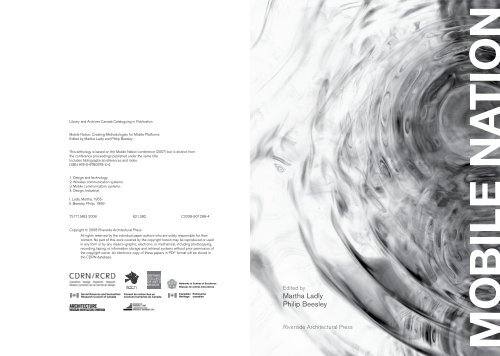
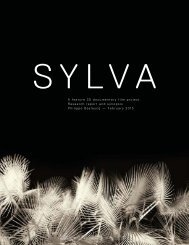
![Digital Architecture Now - Neil Spiller [Publication] - Philip Beesley](https://img.yumpu.com/51382552/1/190x214/digital-architecture-now-neil-spiller-publication-philip-beesley.jpg?quality=85)

